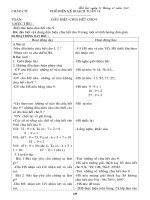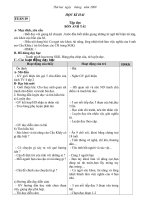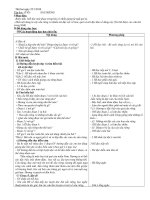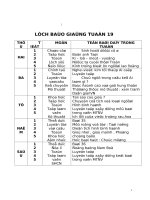Bài giảng GIS Chapter 4 Spatial analysis
Bạn đang xem bản rút gọn của tài liệu. Xem và tải ngay bản đầy đủ của tài liệu tại đây (732.04 KB, 57 trang )
GIS
(Master in Computer Science)
Assoc.Prof. Dr. Trầ n Vĩnh Phư ớ c
E mail:
1
References
1.
2.
Trầ n Vĩnh Phư ớ c (2001). GIS Mộ t số vấ n đề chọ n lọ c. Nhà xuấ t bả n Giáo dụ c.
Trầ n Vĩnh Phư ớ c và các cộ ng sự (2003). GIS đạ i cư ơ ng – Phầ n thự c hành. Nhà xuấ t bả n Đạ i họ c quố c gia Tp. Hồ Chí
Minh.
3.
Trầ n Vĩnh Phư ớ c (2008). GPS – Hệ thố ng đị nh vị toàn cầ u. Nhà xuấ t bả n Đạ i họ c quố c gia Tp. Hồ Chí Minh.
4.
Trầ n Vĩnh Phư ớ c và các cộ ng sự (2009). GIS – Thự c hành ArcMap. Nhà xuấ t bả n Đạ i họ c quố c gia Tp. Hồ Chí Minh.
5.
Trầ n Vĩnh Phư ớ c và các cộ ng sự (2005). Hệ thố ng thông tin đị a lý đồ ng bằ ng sông Cử u Long (MEKOGIS). Đề tài
nghiên cứ u khoa họ c cấ p nhà nư ớ c
6.
David Ardtur, Michael Zeiler (2004). Designing Geodatabases. ESRI Press. ISBN 1-58948-021-X
7.
Graeme F.Bonham-Carter (1994). Geographic Information Systems for Geoscientists: Modelling with GIS, Pergamon
8.
Harvey J. Miller, Jiawei Han (2009). Geographic Data Mining and Knowledge Discovery. Second Edition, CRC Press,
Taylor & Francis Group. ISBN 978-1-4200-7397-3
9.
Kang-Tsung Chang (2008). Introduction to Geographic Information Systems. Fourth Edition. McGraw-Hill. ISBN-13:
978-007-125920-0 or ISBN-10: 007-125920-1
10.
Manfred M.Fischer, Peter Nijkamp (1993). Geographic Information Systems, Spatial Modelling, and Policy Evaluation.
Springer-Verlag. ISBN: 3-540-55454-8 or ISBN: 0-387-55454-8
11.
Phuoc Tran Vinh (2011). A GIS system for real-time monitoring and timely warning. International Conference on
Sustainability Science in Asia (ICSS-Asia) 2011, March 2-4. 2011, Hanoi,.Vietnam. Abstract pp. 49-50,
/>12.
Phuoc Tran Vinh, Hong Nguyen Thi (2011). An Integrated Space-Time-Cube as a Visual Warning Cube. ICMLC 2011,
3rd International Conference on Machine Learning and Computing, Singapore, February 26-28, 2011, IEEE Publisher,
Vol. 4, pp. 449-453. ISBN: 978-1-4244-9252-7 or ISBN: 978-1-4244-9253-4
13.
Phuoc Tran Vinh, Tuyen Le Minh (2011). The Access Control Cube for a Geodatabase of a Provincial Government
Agency. ICMM 2011, International Conference on Innovation and Information Management, Chengdu, China, January
14-15, 2011, IEEE Publisher, pp 397-401. ISBN: 978-1-4244-9450-7 or ISBN: 978-1-4244-9451-4
14.
Phuoc Tran-Vinh (2010). Early Warning Plea for Vietnam. GIM International, Volume 24, Number 5, (Invited Column),
www.gim-international.com
15.
Stan Aronoff (1993). Geographic Information Systems: A Management Perspective, WDL Publications, Ottawa,
Canada
16.
Yue-Hong Chou (1997). Exploring Spatial Analysis in Geographic Information Systems. Onword Press. ISBN: 156690-119-7
2
17.
Websites:
www.esri.com; www.gis-home.net
www.geospatialworld.net; www.mycoordinates.org; www.gim-international.com
What do you need?
T
I
m
MAK
MAKING
c SION
cs
b
m
ow to havea
mtion?
in
patialT
analys
is
3
Chapter 4.
SPATIAL ANALYSIS
1. Introduction
2. Vector Data Analysis
3. Network Analysis
4. Raster Data Analysis
4
Chapter 4.
SPATIAL ANALYSIS
1. Introduction
atial
analysis
SPATIAL
DATA
Crude
Value
INFORMATION
Commercial
Value
5
Chapter 4.
SPATIAL ANALYSIS
1. Introduction
Algorithms
Enter data
Store data
Analyze
data
Display
data
6
Chapter 4.
SPATIAL ANALYSIS
1. Introduction
Visualization
Input data
Geo-Visualization
Store data
Visualize
data
Analyze
visual data
7
Chapter 4.
SPATIAL ANALYSIS
2. Vector Data Analysis
Single Layer Operations: Boundary Operations
Clip
Input Coverage
Clip Coverage
Output Coverage
B1
B1
B4
B4
B5
B5
B2
B2
B3
B3
8
Chapter 4.
SPATIAL ANALYSIS
2. Vector Data Analysis
Single Layer Operations: Boundary Operations
Erase
Input Coverage
B1
B4
Erase Coverage
Output Coverage
B1
B4
B5
B5
B2
B2
B3
B3
9
Chapter 4.
SPATIAL ANALYSIS
2. Vector Data Analysis
Single Layer Operations: Boundary Operations
Update
Input Coverage
B1
B4
Update Coverage
Output Coverage
B1
B5
B2
B2
B3
B3
10
Chapter 4.
SPATIAL ANALYSIS
2. Vector Data Analysis
Single Layer Operations: Boundary Operations
Split
Input Coverage
B1
B4
Split Coverage
Output
B1
B4
B5
B5
B5
B2
B2
B2
B5
B3
B3
11
Chapter 4.
SPATIAL ANALYSIS
2. Vector Data Analysis
Single Layer Operations: Boundary Operations
Append / Mapjoin
B1
B1
B4
B4
B5
B5
B5
B2
Append
B2
B5
B2
B5
B2
B5
B3
B3
12
Chapter 4.
SPATIAL ANALYSIS
2. Vector Data Analysis
Single Layer Operations: Boundary Operations
Dissolve
A
C
A
C
A
Dissolve
D
A
D
E
E
B
B
B
B
13
Chapter 4.
SPATIAL ANALYSIS
2. Vector Data Analysis
Single Layer Operations: Boundary Operations
Eliminate
A
C
A
C
A
Eliminate
D
A
D
E
E
B
B
B
B
14
Chapter 4.
SPATIAL ANALYSIS
2. Vector Data Analysis
Single Layer Operations: Proximity Analysis
Buffer
15
Chapter 4.
SPATIAL ANALYSIS
2. Vector Data Analysis
Multiple Layer Operations: Feature Type
Point-in-Polygon
B1
A3
A1
A3
B3
A2
A1
B2
A2
B4
Point A1 is within the area B2
Point A2 is within the area B4
Point A3 is within the area B3
16
Chapter 4.
SPATIAL ANALYSIS
2. Vector Data Analysis
Multiple Layer Operations: Feature Type
Line-in-Polygon
B1
B3
a3
a1
a2
B2
B4
a3
a1
a2
Line a1 is within the area B2,B4
Line a2 is within the area B3,B4
Line a3 is within the area B2,B3
17
Chapter 4.
SPATIAL ANALYSIS
2. Vector Data Analysis
Multiple Layer Operations: Feature Type
Polygon-on-Polygon
A2
B1
B1
B2
B2
A1
A2
B3
B3
B4
A1
B4
18
Chapter 4.
SPATIAL ANALYSIS
2. Vector Data Analysis
Multiple Layer Operations: Overlay
A
B
A AND B
A OR B
A NOT B
A XOR B
0
0
0
0
0
0
1
0
0
1
1
1
0
1
0
1
0
1
1
1
1
1
0
0
19
Chapter 4.
SPATIAL ANALYSIS
2. Vector Data Analysis
Multiple Layer Operations: Overlay
Union
C
A
B
C1
A1
B1
C2
A1
B4
C3
A2
B4
C4
A1
B2
C5
A2
B2
C6
A2
B3
Attributes
C1
B1
C2
B4
C3
A1
A2
OR
C4
B2
B3
C6
C5
20
Chapter 4.
SPATIAL ANALYSIS
2. Vector Data Analysis
Multiple Layer Operations: Overlay
Intersect
0
B1
0
B3
B3
0
1
AND
B2
0
B4
B4
B2
21
Chapter 4.
SPATIAL ANALYSIS
2. Vector Data Analysis
Multiple Layer Operations: Overlay
Identity
0
0
2
2
1
1
3
3
Input coverage
Identity coverage
Output coverage
22
Chapter 4.
SPATIAL ANALYSIS
2. Vector Data Analysis
Multiple Layer Operations: Overlay
Density/Frequency
0
0
2
2
1
1
3
Point coverage
Area coverage
3
Density coverage
23
Chapter 4.
SPATIAL ANALYSIS
2. Vector Data Analysis
Multiple Layer Operations: Proximity Analysis
Near
Near
0
2
1
3
Base Layer
Target Layer
Point Near Line
24
Chapter 4.
SPATIAL ANALYSIS
2. Vector Data Analysis
Multiple Layer Operations: Proximity Analysis
PointDistance: one-to-one; one-to-many; many-to-many; many-to-all
Base Layer
Target Layer
Output Layer
25









